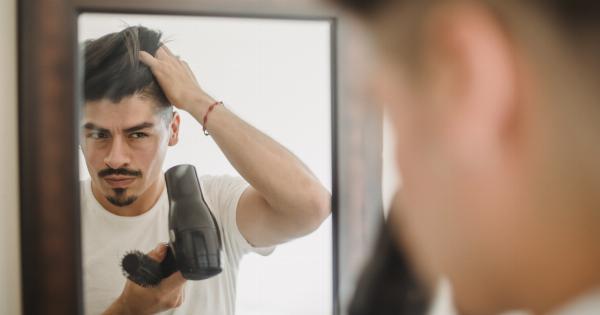Hair loss is a common condition that affects both men and women. While it can be a normal part of aging, it can also be a source of distress and insecurity for many people. One of the most noticeable signs of hair loss is a receding hairline.
Whether you’re just starting to notice your hairline receding or it’s become more pronounced over time, coping with hair loss can be challenging. In this article, we will explore various strategies and tips to help you embrace your changing hairline and boost your confidence.
Understanding Hair Loss
Hair loss, also known as alopecia, can occur due to a variety of reasons. The most common cause of hair loss is male pattern baldness, which is a hereditary condition and affects the majority of men at some point in their lives.
Female pattern baldness can also lead to a receding hairline in women, although it is less common than in men.
In addition to genetic factors, hair loss can also be caused by hormonal changes, certain medical conditions, stress, nutritional deficiencies, and certain medications.
Understanding the underlying cause of your hair loss can help determine the most appropriate treatment options.
Embracing Your Changing Hairline
Acceptance is the first step towards coping with hair loss. It’s important to remember that your worth and attractiveness are not defined by the presence or absence of hair.
Embracing your changing hairline and focusing on your other unique qualities can help boost your self-esteem. Here are a few strategies to help you embrace your changing appearance:.
1. Experiment with Hairstyles
One way to cope with a receding hairline is to experiment with different hairstyles. Consult with a hairstylist who can suggest cuts and styles that work best with your hairline.
Some people find that shorter hairstyles or buzz cuts can actually make hair loss less noticeable, while others prefer longer styles that can be styled to cover the receding areas.
2. Consider Hair-Enhancing Products
There are various hair-enhancing products available in the market that can help disguise a receding hairline. Hair fibers, for example, are tiny particles that cling to your existing hair and create the illusion of fuller hair.
Similarly, scalp powders or sprays can be used to camouflage areas with less hair. These products are temporary solutions and can be a quick fix for special occasions.
3. Opt for a Supplementation Plan
While there is no miracle cure for hair loss, certain supplements can help promote hair growth and prevent further loss.
Consult with a healthcare professional to determine if supplements like biotin, vitamin D, zinc, or omega-3 fatty acids are suitable for you. Keep in mind that supplements may take several months to show noticeable results, so patience is key.
4. Explore Hair Transplant Options
If you’re seeking a more permanent solution, hair transplantation may be a viable option.
Hair transplant procedures involve taking healthy hair follicles from one part of the body (often the back of the scalp) and transplanting them to areas where the hairline has receded. This procedure should be performed by a qualified and experienced professional to ensure natural-looking results.
5. Seek Emotional Support
Coping with hair loss can be emotionally challenging. It’s important to remember that you’re not alone in this experience.
Consider joining support groups or online communities where you can connect with others who are going through a similar journey. Sharing your feelings and experiences with others who understand can provide a great sense of comfort and reassurance.
6. Emphasize Other Features
Remember that your hair does not define your overall appearance. Emphasize and celebrate other features, such as your eyes, smile, or fashion sense.
Invest in grooming routines that make you feel good, such as taking care of your skin, maintaining a well-groomed beard, or experimenting with fashion choices that enhance your personal style.
7. Practice Self-Care
Self-care is essential when coping with any type of physical change or challenge. Engage in activities that bring you joy and help you relax.
Whether it’s practicing yoga, taking long walks, or indulging in a hobby, taking care of your emotional well-being can contribute to a positive mindset and overall confidence.
8. Consult with a Healthcare Professional
If you’re concerned about your receding hairline and experience significant emotional distress, it’s advisable to consult with a healthcare professional.
They can assess your specific situation, provide personalized advice, and recommend appropriate treatment options. Remember that seeking professional help is not a sign of weakness, but rather a proactive step towards finding solutions and support.
9. Consider Hairstyling Alternatives
If you’re open to exploring alternatives to natural hair growth, there are various hairstyling alternatives that can help restore the appearance of a full head of hair.
Wigs, hairpieces, or hair systems can be custom made to match your hair color, texture, and style. These options provide an immediate solution and allow you to experiment with different looks.
10. Remember You’re Not Alone
It’s important to remember that hair loss is a common condition that affects millions of people worldwide. You’re not alone in your experience, and many others have successfully coped with hair loss and embraced their changing hairline.
Seek inspiration from celebrities, influencers, or role models who openly discuss their own hair loss journeys to reinforce the notion that hair does not define beauty or self-worth.
Conclusion
While a receding hairline can be challenging to cope with, adopting a positive mindset and implementing strategies to boost self-confidence can make a significant difference.
Embracing your changing hairline, experimenting with hairstyles, considering hair-enhancing products or supplementation plans, exploring hair transplant options, seeking emotional support, emphasizing other features, practicing self-care, and consulting with healthcare professionals are all effective coping mechanisms. Remember, you are not alone, and there are various resources available to help you navigate this journey with resilience and self-assurance.
























